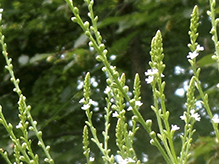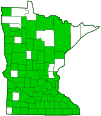white vervain
(Verbena urticifolia)
Conservation • Wetland • Description • Habitat • Ecology • Use • Distribution • Taxonomy
Description |
White vervain is an annual, biennial, or short-lived perennial forb. It rises one to several stems. The stems are erect, slender, 20″ to 60″ tall, moderately to strongly four-angled, and usually branched near the base. They are moderately to densely covered with spreading, straight or somewhat curved hairs. The leaves are opposite and broadly lance-shaped to oblong egg-shaped. They are mostly2″ to 4¾″ long and ¾″ to 2¾″ wide, but larger leaves may be up to 8″ long and 4¾″ wide. They are on ½″ to 2″ long leaf stalks (petioles) that are usually winged above the middle. The blades are unlobed, rounded or short tapered at the base, and tapered to a sharp point at the tip. They do not clasp the stem. The lower surface is hairless or moderately covered with whitish, 1⁄32″ to 1 ⁄16″long, hairs. The margins are somewhat coarsely and sometimes doubly toothed. The inflorescence is a very loosely spreading branched cluster (panicle) of several to numerous spikes at the end of the stem and additional smaller panicles or spikes rising from the upper leaf axils. The spikes are slender, usually stiffly ascending, and 3″ to 20″ long. At first they are relatively short and crowded with buds. As the flowers bloom from the base toward the tip the spike becomes greatly elongated. Only a few flowers on each spike are in bloom at any one time. The blooming flowers do not overlap. The flowers are about ⅛″ wide. There are 5 sepals, 5 petals, 4 stamens, and 1 style. The sepals are green, and are united at the base into a narrowly bell-shaped tube (calyx), then separated into 5 short teeth that are unequal in length. The calyx is hairy and 1 ⁄32″ to 1 ⁄16″ long when in flower, elongating to about 3 ⁄16″ long in fruit. The hairs on the calyx and on the underside of the leaves may be soft and velvety, or short, sharp, stiff, and appressed. The modified leaves (bracts) at the base of each flower are egg-shaped to narrowly egg-shaped and 1⁄64″ to 1 ⁄16″long. They are shorter than the calyx. The petals are white and 1 ⁄16″ to ⅛″ long. They are fused at the base into a slender, funnel-shaped tube then separated into 5 blunt, broadly triangular limbs. Each flower produces a cluster of 4 nutlets that are enclosed in the persistent calyx but are exposed at the tip. Each nutlet is narrowly ellipse-shaped, 5 ⁄64″ long, and smooth, corrugated, or ribbed on the back. |
Height |
20″ to 60″ |
Flower Color |
White |
Similar Species |
|
Habitat |
Moist to moderately moist. Woodland borders and openings, thickets, power lines, trails, disturbed sites. Partial sun. |
Ecology |
Flowering |
June to October |
Pests and Diseases |
|
Use |
|
Distribution |
||
|
Sources Biodiversity occurrence data published by: Minnesota Biodiversity Atlas (accessed through the Minnesota Biodiversity Atlas Portal, bellatlas.umn.edu, 6/7/2025). |
|
| 6/7/2025 | ||
Nativity |
||
Native |
||
Occurrence |
||
Common |
||
Taxonomy |
|
Kingdom |
|
Subkingdom |
Pteridobiotina |
Phylum |
Tracheophyta (Vascular Plants) |
Class |
|
Order |
Lamiales (Mints, Plantains, Olives, and Allies) |
Family |
Verbenaceae (verbena) |
Tribe |
Verbeneae |
Genus |
Verbena (vervains) |
Section |
Verbena |
Series |
Leptostachyae |
Subordinate Taxa |
|
Some sources recognize two varieties. On Verbena urticifolia var. leiocarpa, the hairs on the underside of the leaves and on the calyx are softer, and the nutlet is shorter and smooth on the back. On Verbena urticifolia var. urticifolia, the hairs are stiff and appressed, and the nutlet is shorter and ribbed on the back. According to Steyermark’s Flora of Missouri (Yatskievych, 2013), var. leiocarpa “…which occurs nearly throughout the species range, seems to intergrade freely with the less hairy var. urticifolia and thus should not be provided with formal recognition.” ITIS, USDA PLANTS, and Manual of Vascular Plants (Gleason & Cronquist, 1992) recognize two varieties, var. leiocarpa and var. urticifolia. NatureServe recognizes four varieties, var. leiocarpa, var. urticifolia, var. incarnata and var. simplex. GBIF, GRIN, NCBI, World Flora Online, Plants of the World Online, Catalog of Life, and Steyermark’s Flora of Missouri (Yatskievych, 2013) recognize no varieties. |
|
white vervain (Verbena urticifolia var. leiocarpa) white vervain (Verbena urticifolia var. leiocarpa) |
|
Synonyms |
|
Verbena curtisiae Verbena curtisii Verbena diffusa Verbena incarnata Verbena urticifolia var. incarnata Verbena urticifolia var. leiocarpa Verbena urticifolia var. simplex Verbena urticifolia var. urticifolia |
|
Common Names |
|
burvine nettle-leaf vervain white verbena white vervain |
|
Glossary
Axil
The upper angle where a branch, stem, leaf stalk, or vein diverges.
Calyx
The group of outer floral leaves (sepals) below the petals, occasionally forming a tube.
Panicle
A pyramidal inflorescence with a main stem and branches. Flowers on the lower, longer branches mature earlier than those on the shorter, upper ones.
Petiole
On plants: The stalk of a leaf blade or a compound leaf that attaches it to the stem. On ants and wasps: The constricted first one or two segments of the rear part of the body.
Sepal
An outer floral leaf, usually green but sometimes colored, at the base of a flower.
Challenging Photo
White vervain is difficult to photograph in its entirety. The flower spikes spread widely in all directions and the individual flowers are tiny. The inflorescence tends to get lost against the background and most of it is inevitably out of focus.
Visitor Photos |
||
Share your photo of this plant. |
||
This button not working for you? |
||
Luciearl |
 |
MinnesotaSeasons.com Photos |
||
_01s.jpg) |
_01s.jpg) |
|
Leaves |
||
|
||
|
||
Plant |
|
|
_02s.jpg) |
_02s.jpg) |
|
Leaf |
Stem |

Slideshows |
|

Visitor Videos |
||
Share your video of this plant. |
||
This button not working for you? |
||
|
Other Videos |
||
|

Visitor Sightings |
||
Report a sighting of this plant. |
||
This button not working for you? |
||
| Luciearl August 2019 |
Location: Cass County |
 |
MinnesotaSeasons.com Sightings |
||

|
Created: 11/21/2014 Last Updated: © MinnesotaSeasons.com. All rights reserved. |
